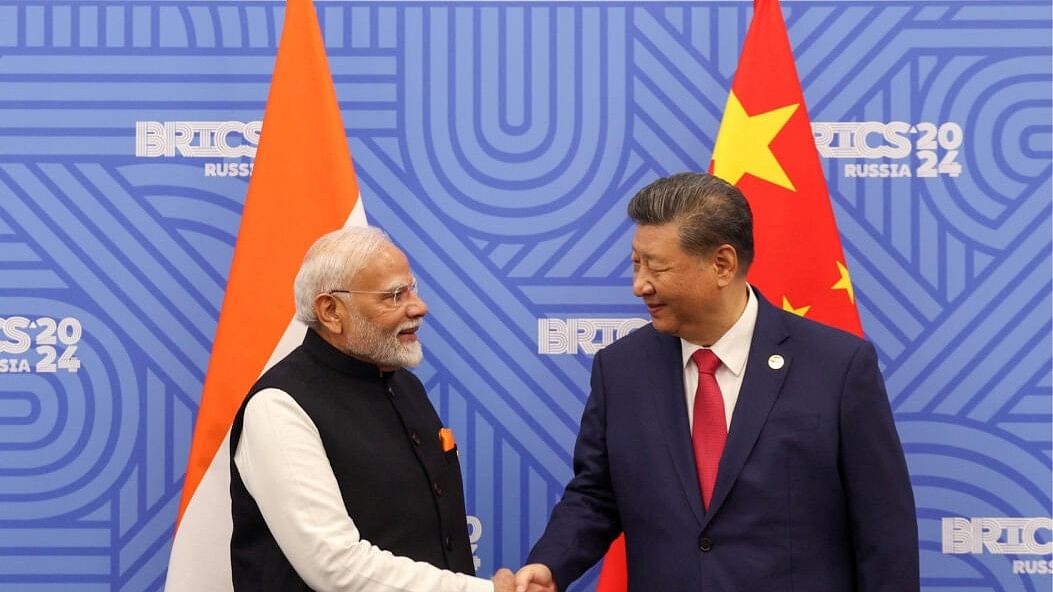
Indian Prime Minister Narendra Modi shakes hands with Chinese President Xi Jinping before their meeting on the sidelines of the BRICS summit in Kazan, Russia, October 23, 2024.
Credit: Reuters Photo
Both optimism-bias and pessimism-aversion could spell trouble while looking at the future of India-China ties — a relationship which is often beset with troubles arising out of their border dispute.
Beijing’s overreliance on ‘historic rights’, the injustices of British imperialism, and China's inconsistent perception of the Line of Actual Control (LAC) make verification the only basis for trust that’s often gets into short supply between the two Asian powers.
However, despite the inherent problems and residual issues that have persisted over the years, Prime Minister Narendra Modi and Chinese President Xi Jinping have a rare opportunity — that comes once in decades — to find a solution to the border dispute.
Both are strong leaders, capable of taking calculated risks without facing likely domestic backlash that they can confidently manage, as land boundary issues are invariably linked to nationalistic constituencies and sentiments, particularly regarding territorial exchanges or questions related to settled populations.
Certainly, Bangladesh is not China, and India has no history of betrayal or war with Dhaka. Nonetheless, reaching a land boundary agreement to peacefully settle the 4,096-km border spanning five states — West Bengal, Assam, Tripura, Meghalaya, and Mizoram — took years of difficult negotiations.
While Sheikh Hasina’s strong leadership was pivotal, the first Narendra Modi government (2014-2019) went the extra mile to overcome last-minute hurdles that had stymied the previous administration including the political opposition. This effort culminated in the successful signing of the 2015 pact, which addressed issues related to the un-demarcated boundary, the exchange of enclaves, and adversely possessed land.
As much as leadership prowess matters, the ground reality and certain compulsions make it imperative for India and China to resolve this issue.
The recent breakthrough in the border stalemate, resolved after four years of intense negotiations, highlighted the limitations of various existing mechanisms established between 1993 and 2013 to address border face-offs. Both sides now need to reach a new set of understandings and agreements to normalise ties, and expedite the process of resolving the boundary, which ultimately hinges on bold political mandates from the leadership.
Although Beijing has never been consistent in its perception of the LAC, its recent behaviour has been both more unpredictable and intemperate.
In a letter to leaders of Asian-African countries explaining his reasons for declaring war on India, Zhou Enlai wrote: “The line of actual control is not equivalent to the boundary between the two countries. Acknowledging and respecting the line of actual control would not prejudice each side’s adherence to its claims on the boundary.” Military conduct — such as frequent face-offs between patrolling parties, attempts to change the status quo, and temporary military build-ups — has further contributed to differing perceptions and a growing disregard for the LAC.
Indeed, there has been a noticeable departure from the initial proposals of the Chinese leadership regarding military activities in the border areas. In 1959, Beijing suggested that “the armed forces of both sides withdraw 20 kilometres from the LAC along the entire Sino-Indian border and halt patrols.” However, by the mid-1970s, the People’s Liberation Army (PLA) “no longer stayed 20 kilometres behind the Chinese version of the LAC in all places,” with physical scuffles becoming increasingly frequent in later years.
Since the 1993 understanding on border management, Beijing has not completely refrained from frequent border incursions. However, it has largely adhered to a political understanding that peace and tranquillity along the border are essential for a good ties with India. This has been broken now with the 2020 border incidents, restoring of which though might take time will be a political process.
On the other hand, both India and China have increased their stature and political ambition over the last three decades. While China remains the larger economy and military power, India has made significant strides in closing the military gap through indigenous development, weapon acquisitions, and a series of military agreements with major global powers. China’s recent rise has proven anything but benign, which has heightened India’s relevance as a countervailing force. Although China’s economic might surpasses India’s, India has enhanced its political influence and ability to forge ties with countries of all hues and stripes.
That said, engaging in business with China has become a compelling factor for companies worldwide, and India cannot afford to ignore this trend. Many Western countries that politically oppose and criticise China have nonetheless played a key role in establishing it as a hub for manufacturing and supply chains for their benefit.
While these realities persist, both India and China have sufficient space in the world to compete, co-operate, and manage their differences.
This presents a unique opportunity for Modi and Xi to shape a future that fosters peace and prosperity for their nations, the region, and the world. Domestically the political stars have aligned in favour of both these leaders; the massive support Modi and Xi enjoy in India and China respectively is unlike anything seen in the past few decades. Given this, Modi and Xi must not miss this window of opportunity to settle the border dispute between India and China.
(Jayanth Jacob, a foreign policy commentator, has covered the Ministry of External Affairs for over two decades. X: @jayanthjacob.)
Disclaimer: The views expressed above are the author's own. They do not necessarily reflect the views of DH.